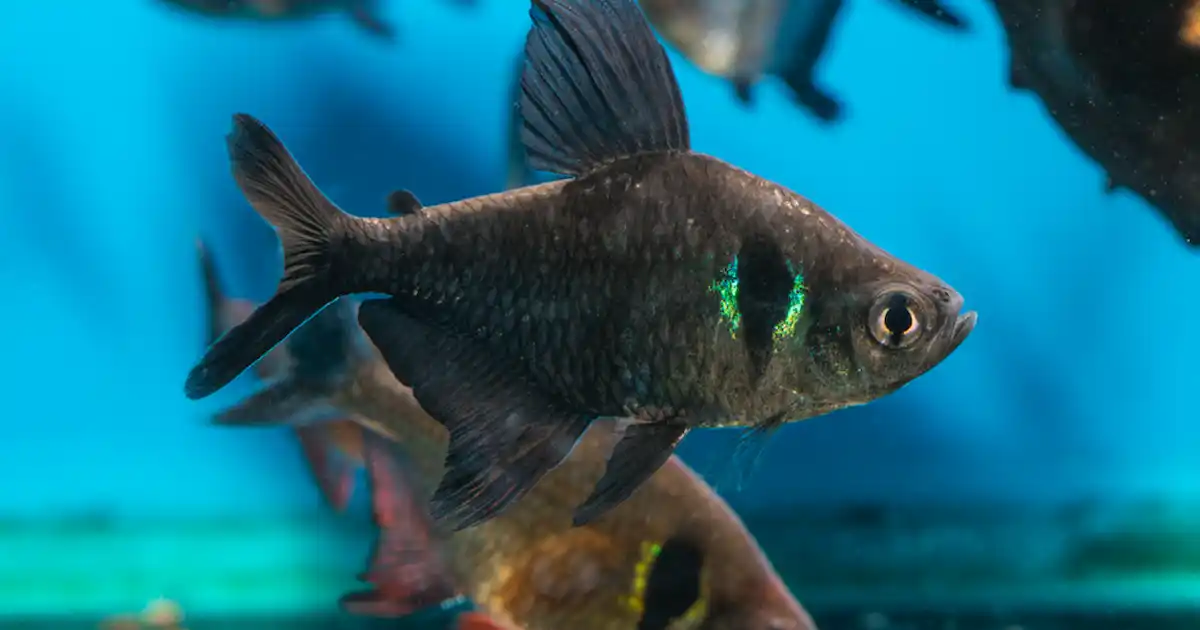Practical Fishkeeping contains an article on the Black Phantom Tetra, Hyphessobrycon megalopterus (Eigenmann, 1915), in the latest edition. I'll put the link to the article below; the video is worth viewing. The author, Tai Strietman, writes that this species in the wild is red, not black, and the fish in the video seem to bear this out, at least for this specific location which is the Salobra river of Mato Grosso do Sul in the Pantanal wetlands of Brazil.
As indicated in the article, decades ago when the fish was first imported, it was bred to be black. The black form does not seem to exist in the wild. Flavio Lima, an eminent authority on the Characidae family, confirms that he has caught specimens of this species that have somewhat greater darkness, and it may be surmised that such "darker" fish may have been the source for the black breeding.
I have never come across this fact in any of the sources for information on this species. Gery, Weitzman, Baensch & Riehl (authors of the excellent five volume set Aquarium Atlas), and other icthyologists active during the 20th and early 21st centuries do not to my knowledge mention this anywhere. I have not been able to find (online) the 1915 description of this species by Eigenmann to see what if anything he reported as to the colour of the species.
So my natural instinct was to question the people who know on the characin FB site. Within minutes I was in communication with the author who is also a member. His supervisor for his thesis is not only an acknowledged authority on the Characidae family, but the principle taxonomic expert on the genus Hyphessobrycon, Fernando R. Carvalho. Dr. Carvalho has authored singly or jointly more than 60 scientific studies/articles on fish. When I mentioned to Tai that earlier writers don't seem to have mentioned this, he said that was a good point and he would raise it with Dr. Carvalho.
BTW, the majority of red fish in the video are Hyphessobrycon eques, the Serpae or Red Minor Tetra, which is related to the subject species, but if you are observant you will see several "Black Phantoms" that are clearly shoaling with the H. eques, another interesting fact.

 www.practicalfishkeeping.co.uk
www.practicalfishkeeping.co.uk
As indicated in the article, decades ago when the fish was first imported, it was bred to be black. The black form does not seem to exist in the wild. Flavio Lima, an eminent authority on the Characidae family, confirms that he has caught specimens of this species that have somewhat greater darkness, and it may be surmised that such "darker" fish may have been the source for the black breeding.
I have never come across this fact in any of the sources for information on this species. Gery, Weitzman, Baensch & Riehl (authors of the excellent five volume set Aquarium Atlas), and other icthyologists active during the 20th and early 21st centuries do not to my knowledge mention this anywhere. I have not been able to find (online) the 1915 description of this species by Eigenmann to see what if anything he reported as to the colour of the species.
So my natural instinct was to question the people who know on the characin FB site. Within minutes I was in communication with the author who is also a member. His supervisor for his thesis is not only an acknowledged authority on the Characidae family, but the principle taxonomic expert on the genus Hyphessobrycon, Fernando R. Carvalho. Dr. Carvalho has authored singly or jointly more than 60 scientific studies/articles on fish. When I mentioned to Tai that earlier writers don't seem to have mentioned this, he said that was a good point and he would raise it with Dr. Carvalho.
BTW, the majority of red fish in the video are Hyphessobrycon eques, the Serpae or Red Minor Tetra, which is related to the subject species, but if you are observant you will see several "Black Phantoms" that are clearly shoaling with the H. eques, another interesting fact.

Black phantoms in the wild!
The Black phantom tetra, Hyphessobrycon megalopterus, is actually red in the wild! The reasons for it being bred into black-blue forms (especially the males) after being brought to the hobby are not quite clear, but it may have been to differentiate them from Hyphessobrycon eques, the Serpae...



